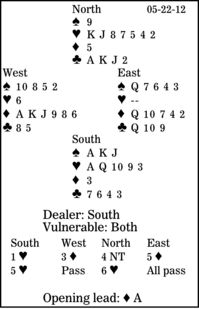Bridge column, May 22: Which opponent has which queen?

In contrast to chess, in bridge a king is more powerful than a queen. But sometimes a deal revolves only around queens, not kings -- as in this example.
North barrels his partner into six hearts. West leads the diamond ace and shifts to his trump. How should South continue?
When East bid five diamonds over Blackwood, he was hoping that his opponents had not discussed this situation. But they were using D0P1: double -- zero aces, pass -- one ace, next step -- two aces, etc. Hence, South's five-heart rebid.
South has 11 top tricks: two spades, seven hearts and two clubs. The extra winner could come from either black suit, with a winning finesse or a queen dropping in a timely manner.
The basic principle with two finesses against queens is to cash the ace and king in the suit with the greater number of cards. If that queen drops, fine; if it does not, finesse in the other suit. So, declarer should cash the ace and king of clubs. When the queen does not drop, he plans on taking the spade finesse, but first he should run all the trumps, discarding his last two clubs and bringing everyone down to three cards.
Here, East must keep the club queen and come down to queen-doubleton in spades. Now South cannot go wrong. Checkmate!
** ** **
COPYRIGHT: 2012, UNITED FEATURE SYNDICATE
DISTRIBUTED BY UNIVERSAL UCLICK FOR UFS

